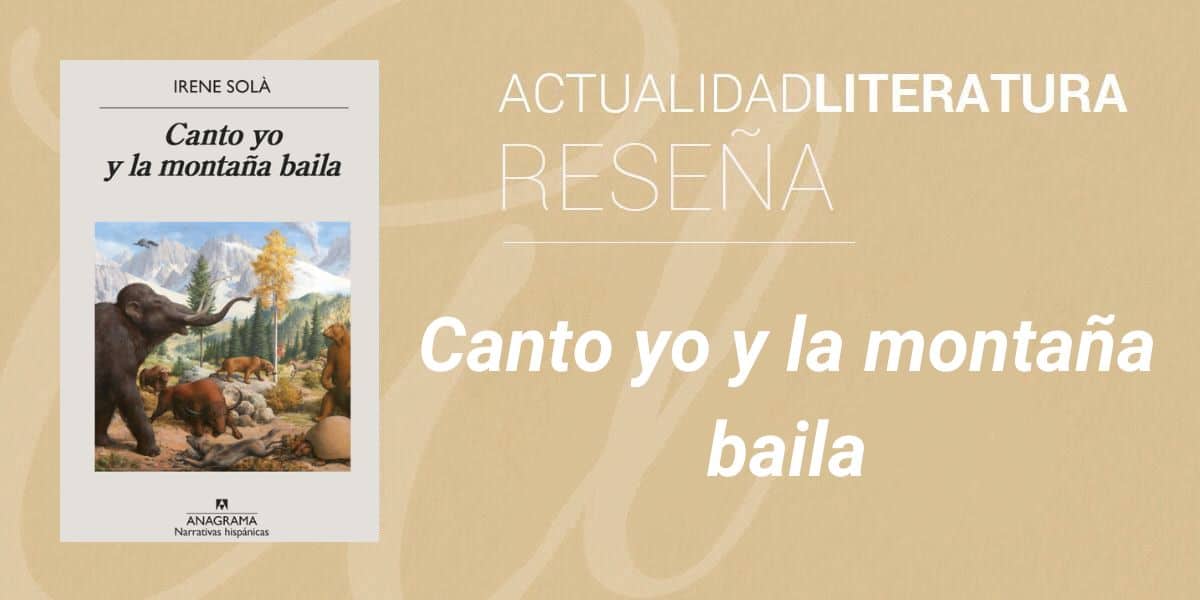
I sing and the mountain dances
I sing jo i la muntanya ball —original name in Catalan— is a rather striking and original novel based on the alliteration of the title itself. However, this book by the Barcelona poet, narrator and plastic artist Irene Solà Sàez is much more than the clever play on words on its cover. It's actually a very well-constructed story carried by characters that are unique, deep, and at the same time wonderfully diverse.
Of that way the reader is hopelessly submerged in a fantastic world inspired by myths, legends and the geography of the mountains catalan. There, all the elements have a voice: the wind, the sun, the clouds, the animals, the plants, the fungi... These expressions constitute the core of a plot with room for all kinds of emotions and surprises at every turn of the page.
Analysis and summary I sing and the mountain dances
Stage
The setting of the novel It has been described as sublime by the majority of Spanish-speaking literary critics. To begin with, the representation of the Catalan Pyrenees reflects a unique vision of the mountains and the charm of their rural daily life. Similarly, the lyrical composition of the text conveys to the reader the feeling of breathing fresh air and full freedom (in body, mind and soul).
Notably The mountain range is one more character in the story, with its own expression beyond the omnipresent sensation of peace in the natural environment. No However, that seemingly perpetual tranquility also hides a lot of movement —imperceptible to the unwary eye—, mysteries, surprises, and dangers. These twists are presented in eighteen chapters that are each told by a different narrator (none of them repeats).
A great collective song
On some occasions it is a person of flesh and blood who describes events according to your point of view. In others, it is the soul of a fallen; suddenly a mushroom take the floor then a deer, after, a bitch… like this until the magic takes over the entire vibrant mountain. Even the clouds, other animals and some non-living entities have their particular expression space to form a beautiful group song.
But Despite not constituting a homogeneous chorus, each word has a reason, since no statement is meaningless or random.. For this reason, Solà's great merit is having created a very coherent narrative thread through many phrases that are so different from each other. All these voices appear in the first person to give the story a cadence that takes the reader by the hand and invites them to dance with nature.
Plot and style features
The story revolves around three generations of a family inhabiting the Pyrenees from the Civil War to the present. Over there, the experiences of the protagonists are narrated through monologues (subjective) of each element. Initially, the testimonies appear scattered and even somewhat strange to the reader. But, that puzzle is an organized mess, since everything fits perfectly at the end of the 168 pages of the book.
For these reasons, I sing and the mountain dances it seems more like a theatrical text in most of its chapters. In parallel, the development leaves room for chaotic passages of life and death along with unexpected shocks that keep the reader hooked. However, such an abundance of fanciful interventions (a mountain that expresses its feelings, for example) does not detract from the text's coherence.
Documentation
Irene Solà Sàez explained in this book her ability to emotionally impact her readers through a poetic narrative and the evocation of artistic images. Consequently, all the sentences in the text have a specific meaning and a specific intention. within an amalgamation of ideas marvelously embodied through a very deep lexicon.
Notably that expressive richness together with some dreamlike touches and certain features of magical realism are never excessively ornate.
Additionally, the Spanish author demonstrated her virtues as an expert researcher due to her excellent handling of events, beliefs and characters linked to the myths and legends of the Pyrenees. Although these stories are well known within the Catalan culture, people from other territories rarely know about any of these traditional narratives.
Phrases of I sing and the mountain dances
- «We arrived with full bellies. Sore. The black belly, loaded with dark and cold water, and with lightning and thunder»;
- “I was full of things that happened to me”;
- "Waiting was more tiring than walking";
- "In the mountains there is no war, that wars end but the mountains do not."
About the author, Irene Solà Sàez

Irene Solà Sáez
Irene Solà Sàez was born on August 17, 1990, in Malla, a municipality in the Osona region, Barcelona province, Catalonia, Spain. He obtained his degree in Fine Arts at the University of Barcelona and an MA in Literature, Film and Audiovisual Culture from the University of Sussex. Since her days as a university student she has worked with multidisciplinary artistic research and on issues related to literature.
In fact, his literary debut, the collection of poems Beast (Galerada, 2012), appeared when she was still in higher education and won the XLVIII Amadeu Oller Award. In the words of the author from Oson, the first half of her debut is an expression of visceral resentment with the world. In contrast, the second section of the text shows a much calmer temperament and a pleasant tone.
Trajectory and recognitions
In 2018, Solà published her first novel the dics (the levees, in Catalan), winner of the Documenta Award narrative for under 35 years. It is a string of stories about three generations from the perspective of Ada, the protagonist. Certainly the book is a compilation of micro-stories that are part of a mosaic that is as particular as it is collective of the universe.
Finally, I sing jo i la muntanya ball (2019) is considered the consecration work of the Catalan writer. Not surprisingly, his style of approaching narratives —with a methodology similar to that of an artistic investigation— has been highly praised and recognized in the Spanish literary sphere. For this reason, Solà has emerged as one of the most promising young writers today.
Among the decorations received after the publication of I sing and the mountain dances, they find each other:
- Anagrama Prize for a Novel in Catalan (2019);
- Punt de Llibre Award from the digital magazine Núvol (2019);
- Cálamo Award, 'Another Look' category (2020);
- European Union Prize for Literature (2020).
